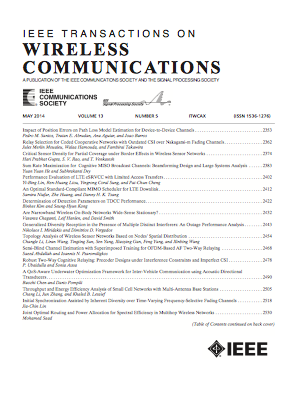具有通道训练的可重构智能表面:频谱效率和最佳阵列尺寸
IF 10.7
1区 计算机科学
Q1 ENGINEERING, ELECTRICAL & ELECTRONIC
引用次数: 0
摘要
在可重构智能表面(RIS)中,反射元素增加了整个通道模型的维数,相应地增加了训练要求。本文分析了信道训练和频谱效率如何指导RIS操作维数的选择。我们推导了基于训练的容量的内界,作为导频功率、数据传输功率和RIS阵列尺寸的函数。我们根据可实现的速率指标研究了ris辅助系统中数据/先导功率优化的结果和含义。此外,这项工作揭示了在优化端到端容量时,一方面是更大RIS的优越阵列增益,另一方面是各自的训练需求之间的权衡。超过一定的临界阵列尺寸后,由于训练要求,阵列尺寸的进一步增大不利于频谱效率的提高。计算了该临界尺寸,并阐明了其与信道信噪比(SNR)和相干间隔的关系。在此背景下,分析了不同训练方案的优缺点,并通过仿真进行了验证。本文章由计算机程序翻译,如有差异,请以英文原文为准。
Reconfigurable Intelligent Surfaces With Channel Training: Spectral Efficiency and Optimal Array Dimensions
In reconfigurable intelligent surfaces (RIS), the reflective elements increase the dimensionality of the overall channel model and, correspondingly, the training requirements. This paper analyzes how channel training and spectral efficiency guide the choice of the operational dimensionality of RIS. We derive an inner bound on the training-based capacity as a function of pilot power, data transmission power, and RIS array dimensions. We study the outcomes and implications of data/pilot power optimization in RIS-assisted systems according to the achievable rate metric. Further, this work sheds light on the tradeoff between the superior array gains of larger RIS on the one hand, and the respective training requirements on the other hand, when optimizing the end-to-end capacity. Beyond a certain critical array size, further increase of array size is not beneficial for spectral efficiency due to the training requirement. This critical size is calculated, and its dependence on the signal-to-noise ratio (SNR) and coherence interval of the channel is clarified. The benefits and drawbacks of different training schemes are analyzed in this context, and demonstrated by simulations.
求助全文
通过发布文献求助,成功后即可免费获取论文全文。
去求助
来源期刊
CiteScore
18.60
自引率
10.60%
发文量
708
审稿时长
5.6 months
期刊介绍:
The IEEE Transactions on Wireless Communications is a prestigious publication that showcases cutting-edge advancements in wireless communications. It welcomes both theoretical and practical contributions in various areas. The scope of the Transactions encompasses a wide range of topics, including modulation and coding, detection and estimation, propagation and channel characterization, and diversity techniques. The journal also emphasizes the physical and link layer communication aspects of network architectures and protocols.
The journal is open to papers on specific topics or non-traditional topics related to specific application areas. This includes simulation tools and methodologies, orthogonal frequency division multiplexing, MIMO systems, and wireless over optical technologies.
Overall, the IEEE Transactions on Wireless Communications serves as a platform for high-quality manuscripts that push the boundaries of wireless communications and contribute to advancements in the field.

 求助内容:
求助内容: 应助结果提醒方式:
应助结果提醒方式:


